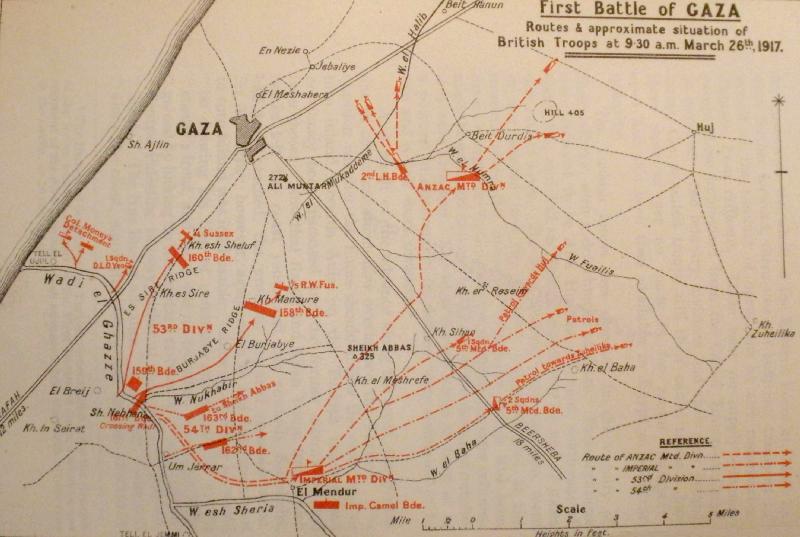Topic: BatzP - 1st Gaza
The First Battle of Gaza
Palestine, 26 to 27 March 1917
Falls Account Part 2
Falls Account Sketch Map 14.
The following is an extract of the Falls Account from the the Official British War History volumes on Egypt written by Falls, C.; and, MacMunn, G., Military operations: Egypt and Palestine, (London 1928), pp. 279 - 325 detailing the British role at the First Battle of Gaza, Palestine, 26 to 27 March 1917.
Falls, Chapter XVI The First Battle Of Gaza
The First Battle of Gaza.
The preliminary moves and approach march.
On the 20th March the head of the Eastern Force was at Rafah, 18 miles from Gaza, with outposts at Khan Yunis. Here were the two mounted divisions and the headquarters of the Desert Column. Advanced headquarters of the Eastern Force also moved to Rafah on this date. The remainder of the force was echeloned further west, both for convenience of supply and to avoid a concentration which would indicate to the enemy preparations for an immediate advance. The Camel Brigade, the 52nd Division, and one brigade of the 54th Division were at Sheikh Zowaiid, 29 miles south-west of Gaza, and the remainder of the 54th at El Burj, 8 miles further west. The 53rd Division was encamped upon prepared defences 4 miles south-west of Rafah. G.H.Q, was still at Cairo.
On the 21st March the first step was taken in a series of preliminary moves, arranged in accordance with the exigencies of water supply and made chiefly at night. One brigade of the Imperial Mounted Division advanced to khan Yunis, where the groves gave considerable concealment; the 53rd Division concentrated at Rafah, and the 54th Division closed up upon its leading brigade at Sheikh Zowaiid. The next two days were occupied by preparations and the move of auxiliary units. On the 24th the advance was resumed the 53rd Division moving from Rafah to Khan Yunis and the 54th from Sheikh Zowaiid to Rafah. By midnight on the 25th the force was concentrated close to the Wadi Ghazze as follows:The two mounted divisions and the 53rd Division at Deir el Balah;
The 54th Division at In Seirat, 2 miles east of Deir el Bal ah;
The 52nd Division at Khan Yunis;
The Camel Brigade at Abasan el Kebir, 5 miles south-east of Khan Yunis.
The 53rd Division thus had a march of seven miles to Deir el Balah, which began at dusk on the 25th to avoid the observation of enemy aircraft. After a halt of between three and four hours, the division then had to face another march of four miles before it reached the crossings of the Ghazze. As some three miles more of broken ground east of the wadi had to be crossed before Mansura and Esh Sheluf were reached, it will be seen that a heavy call upon the Division's endurance was to be made before it was committed to the attack.
At 2.30 a.m. on the 26th the A. & N.Z. Mounted Division left its bivouac at Deir el Balah and moved across the rear of the 54th Division at In Seirat to the previously prepared crossing at Um Jerrar, 4½ miles east of Deir el Balah, reaching the wadi without hitch or delay, followed by the Imperial Mounted Division. The Camel Brigade left Abasan el Kebir in the early morning (There is no record of the hour at which it left its bivouac.) and moved to its crossing at Tell el Jemmi, south of Um Jerrar, also arriving without mishap, though the night was of inky blackness.
The 53rd Division moved out from Deir el Balah at 1 a.m. in four columns: three brigade groups (Each had only one section of a field company R.E., and one bearer sub-division of a field ambulance R.A.M.C., in addition to the establishment of the brigade.) and Money's Detachment, all save the last-named with orders to be at a place of assembly close to the Wadi Ghazze in the neighbourhood of El Breij by 2.45 a.m. The 160th Brigade (Br.-General W. J. C. Butler) was to cross at 3.30 a.m., the 158th Brigade (Br.-General S. F. Mott) at 3.45 a.m., while the 159th Brigade (Br.-General J. H. du B. Travers) was to follow the 158th. The artillery was to form up at In Seirat and cross after the 158th and 160th Brigades had advanced sufficiently to ensure its safety: the 266th Brigade R.F.A. following the 158th Brigade Group, the 265th Brigade R.F.A. and one section 10th Heavy Battery following the 160th Brigade Group. (It must, however, be understood that though an artillery brigade marched with each of the leading infantry brigade groups, it was not at the tactical disposition of the brigadier, but at that of the divisional commander, through his C.R.A. General Dallas was influenced in making this arrangement by the fact that he had only two field artillery brigades to support three infantry brigades. He did not desire to split up his already inadequate artillery formations in order to allot batteries to the 159th Brigade.)
The movements all took place in accordance with orders, except that of the 158th Brigade. In its case the officer detailed as guide lost his way and the brigade was eventually led to the wadi by Br.-General Mott, arriving 50 minutes late at 4.35 a.m.
Money's Detachment moved down to the wadi near the shore, ready to cross at dawn, and the section of the 91st Heavy Battery, covered by the divisional cavalry squadron (Duke of Lancaster's Own Yeomanry) moved to a good position, previously reconnoitred, on the Rafah-Gaza road.
The development of a supply of water from the Wadi Ghazze (which, though now nearly dry, had numerous springs in its bed) by the divisional engineers was begun directly the infantry had crossed. A supply sufficient for all the troops engaged was obtained, long rows of canvas troughs being put up for the watering of horses.
Sir C. Dobell moved his battle headquarters from Rafah to just north of In Seirat, where he arrived at 6.45 a.m. and took up a position overlooking the wadi, then veiled in mist. General Chetwode also established his headquarters here, with the intention, as stated in his orders, of moving later to Sheikh Abbas. Owing to the fog, to the delay which it caused in the attack of the 53rd Division, and to the early attainment of, their objectives by the mounted troops, General Chetwode did not, however, move his headquarters across the Wadi Ghazze but conducted the operation from In Seirat. He was thus able to discuss personally with Sir C. Dobell the problems which arose in the course of the day. In this there was advantage, but it was perhaps counter-balanced by the fact that the subordinate of two commanders almost inevitably feels himself cramped in his conduct of an action if his superior is "on top" of him; (The two headquarters were actually, and remained all day, side by side, in the open and without cover of any sort.) as, for instance, when General Sir Charles Warren was conducting the Spion Kop operation in 1899, with General Sir Redvers Buller looking on. General Dallas's battle headquarters was first established at 3.45 a.m. near El Breij, on the left bank of the Wadi Ghazze.
Sir A. Murray established an advanced headquarters in a railway train at El Arish, in order to be in touch with Sir C. Dobell. He arrived at 6 p.m. on the 25th and was in telegraphic and telephonic communication with the Eastern Force exchange at Rafah.
We have thus the following chain of command: Advanced G.H.Q. at El Arish; Eastern Force headquarters, the equivalent of the Army, near In Seirat; Desert Column headquarters, the equivalent of the Corps, at the same point. But G.H.Q. was without reserves, so that its influence upon the battle was confined mainly to that of advice. The smallness of the staffs of Eastern Force and Desert Column must also be noted. The total force under Sir C. Dobell's command consisted of two mounted divisions, a brigade of Camel Corps, three infantry divisions; that is to say, it was larger and far more complicated than a normal army corps. Yet his staff was smaller than that of an army corps on the Western Front at this period. At his advanced headquarters he had three general staff officers only, of whom two were out for a great part of the first night of the battle, endeavouring to ascertain the situation. General Chetwode's staff was the equivalent of that of an infantry division, the chief general staff officer being a G.S.O. 1st Grade. When a staff is too small for its functions the price paid in battle is excessive strain, lack of sleep, and consequent liability to error.
Previous: Falls Account Part 1, The Situation in Late March, 1917.
Next: Falls Account Part 3, The Fog at Dawn on the 26th March.
Further Reading:
The First Battle of Gaza, Palestine, 26 to 27 March 1917
The First Battle of Gaza, Palestine, 26 to 27 March 1917, Allied Forces, Roll of Honour
The Palestine Campaign, 1917 - 1918
Battles where Australians fought, 1899-1920




